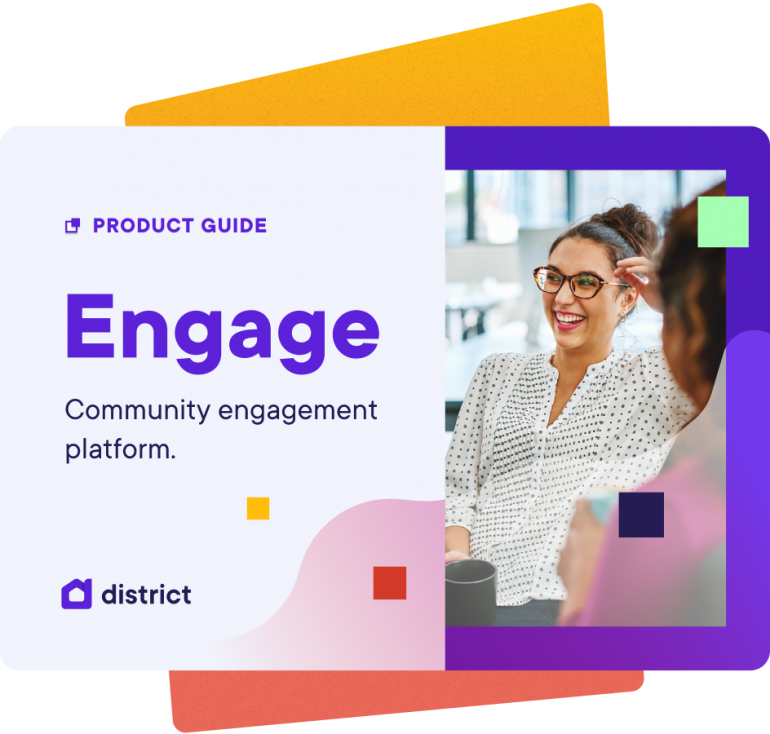At the heart of effective governance and community engagement is a great citizen experience.
For governments and their agencies to serve and empower their citizens, they need to adopt a citizen-centred approach when they design services and platforms.
That's why the user is at the heart of everything we do at District. At every step of the way, from research and discovery, to implementation and testing, we make sure our products and services are designed with people in mind. Along the way, we use co-design practices to make sure the custom solutions we create for our clients meet their needs and solve their unique problems.
So, why is user-centric design important?
In this article, we'll take a look at the impact of user-centric design at District, and how it can help to boost the effectiveness of your engagement project. Plus, we'll see what the future of citizen-centric services looks like.
Why is user-centred design important?
To design great digital services for the public, you need to make sure they are great to use. That's why user-centric design is important.
Empathy and understanding
Putting users at the front and centre of the design process helps ensure you get deep insights into the needs, preferences, and pain points of the people who use a service. This empathy-driven approach helps you design solutions that are meaningful and resonate with users.
At District we use design methodology practices and UX tools to get to know the users, so we can design unique solutions that meet their needs and solves their problems.
Usability and accessibility
When you prioritise the user experience, you create platforms and services that are intuitive, easy to navigate, and accessible to everyone. At District, we user test throughout the development process to ensure that we remove barriers, accomodate diverse needs, and maximise accessibility and usability.
Engagement and satisfaction
When citizens feel heard, valued, and empowered through well-designed services, their engagement and satisfaction levels soar. User-centric design cultivates trust, loyalty, and a sense of ownership among users that drives positive outcomes.
District Engage makes sure the community can continue to be part of the journey by closing the feedback loop with tools such as updates and notifications.
How to incorporate user-centric design in citizen-services
District Engage has been designed with the citizen experience at the centre of the platform.
Citizen needs and preferences
To understand the unique needs, challenges, and aspirations of our users, we conduct research, engage in active listening, and use surveys and user testing. All of these insights informs the design process and helps us to ensure our solutions align functionality with user expectations.
Accessibility and inclusivity
All users should enjoy equal access to a digital service. We prioritise accessibility standards and inclusive design principles to accommodate all users regardless of their abilities or backgrounds, including language preferences, cultural contexts, and level of digital literacy.
Data privacy and security
Upholding data privacy and security measures to protect citizens' information is essential. Our transparent data practices and robust cybersecurity protocols instil trust and confidence, and helps to foster a safe and secure environment for community consultations.
How to boost your engagement campaign
No matter how amazing your community engagement platform is, the real test of its effectiveness and impact will be how much it's used by the public. To increase community engagement, here are three tips to encourage the public to sign up:
1. Streamline the onboarding process
Minimise steps and eliminate unnecessary barriers to sign up, with clear instructions, intuitive interfaces, and user-friendly forms.
2. Promotion and outreach
Target your marketing campaigns to raise awareness and promote the benefits of your community engagement platform. Leverage social media, email newsletters, and community events to reach a wide audience and generate interest.
3. Incentives and rewards
Consider incentives or rewards to encourage public sign-up and engagement and motivate users to take action and become active participants.
The future of citizen-centric services
Key trends shaping citizen-centric services in the future include:
Personalisation and customisation
Citizen-centric services will become increasingly personalised and tailored to individual preferences and needs.
Integration of emerging technologies
Emerging technologies such as artificial intelligence, machine learning, and blockchain will enable more efficient, transparent, and secure interactions between government and citizens.
Data-driven decision making
Data analytics and predictive modelling will play an increasingly central role in driving informed decision-making and policy formulation.
A great experience on a digital service starts with a commitment to user-centred design. By understanding our audience, prioritising accessibility, and boosting engagement, we can create citizen-centric services that empower individuals, strengthen communities, and drive positive social change.
Empower your organisation to embrace user-centred design and drive meaningful change in citizen engagement. Talk to our District Engage consultants today.



